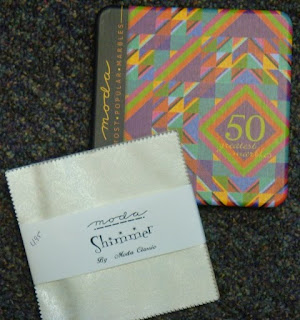Squares Technique #3
With the previous technique in tutorial part 4, we made two HSTs from a square. However, accuracy is still a factor with all the prevous HSTs tutorials. One solution is to make the square large enough so that both halves can be sewn to the correct size for your pattern. Also, cut your square 1" larger than finished size as compared to 7/8" in tutorial #4. So, cut 2 squares 4" from two different fabrics.
Draw a line diagonally from corner to corner on one square. Place right sides together and sew 1/4" on each side of drawn line.
Cut apart on drawn line.
Now you have two HSTs. But wait, they are too big. We need to square them to size. I will describe three types of rulers in the market you can use.
The traditional square up ruler is made by many companies in various different sizes. I want to emphasize using a ruler compatible to the size square you are squaring to size. Don't use a 12.5" square up ruler to trim a 4.5" HST. Use one that is 4.5" or 6.5". In photo below, I was just too lazy to retrieve my 4.5" ruler. To use this ruler (I'm LEFT HANDED so bare with the photos) place the diagonal line of the ruler on the diagional seam of the HST. Note that I have a little room to trim the HST to 3.5" on all edges of the unit under the ruler. Once you are satisfied, trim the left and top edges of the HST.
This photo show the left and top edges trimmed.
Turn the partially trimmed HST 180 degrees. Again, place ruler with diagonal line on seam line of HST. Note in photo below that the 3.5" lines on the ruler is now aligned with the edges we trimmed in previous photo.
Again, trim left and top edges.
Here is your perfect HST!
June Tailor has a square up ruler that is a little different called "Perfect Half-Square & Quarter-Square Triangles. It's my favorite method to use when making scrappy HSTs.
The packaging gives detailed information on how to use this ruler. Here is a quick lesson. Place the half square triangle under the ruler with one of the diagional lines on the seam of the HST. It is important that the HST is placed between the cutting lines for the size you want but with scant amounts overlapping so you can trim. Does not have to be centered. I then cut on the two 3.5" slots in the ruler. (Hopefully the photo shows this.)
This what I have after cutting through the two slots at 3.5" I pulled the HST up a bit so you can see what was trimmed.
Now turn the HST one quarter turn. Place the ruler back on the HST with diagonal along the seam line and the TOP 3rd line going left to right is on top of the HST. (This is hard to type, so look at photo carefully. The first horizontal line above the 45 degree markings would be used for 1.5" HST, the 2nd for 2.5" HST, etc. Trim again in both 3.5" slots.
This is what you will have after trimming. Another perfect HST!
This method is a little different using the HST ruler from Quilt in a Day.
Do NOT press HST open to use this ruler! HST is squared up prior to pressing. For a 3" finished HST, place the 3.5" line on the ruler with the seam line of your HST.
Trim on both sides of the ruler as shown.
Press seams open and ta-da, you have a perfect HST! Only problem with this ruler is that you still have dog ears to trim.
Pros:
1. Very accurate as triangles are trimmed after sewing.
2. Do not have to handle bias edges.
3. Using two of the rulers above takes care of the dog ears while trimming.
Cons:
1. You will have to draw a diagonal line down the center and if you are making a lot of squares this can be tedious. You could use the Angler 2 to sew seams or mark your sewing machine bed.
2. Need to trim dog ears using one of the above rulers.
3. Is time consuming to square up the HSTs, expecially if you need 200 of them!
4. Will need to invest in square-up ruler/s of your choice.
Solution:
1. If you need a lot of HSTs, try using paper piecing method, grid piecing method, or bias strips method. These topics will be discussed in future tutorials.
If you have used these rulers, leave a comment on your favorite.
PS - This is my 100th post!
--------------------------
Type-u-later,
Tea in MO
http://www.teaquilts.com

























































